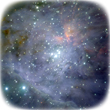

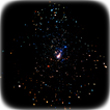


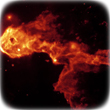
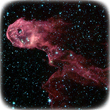
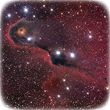
























To study star formation in the Kleinmann-Low region, behind the Orion Nebula, the size of the telescope really matters. The larger it is the finer the detail that can be captured in images of the sky. The largest telescope on Earth is the Very Long Baseline Array or VLBA, which radioastronomers use regularly to resolve objects in the cosmos 1000 times more finely than can be done even with the Hubble Space Telescope. The resolution of the VLBA is amazing. It could distinguish something in Chicago as small as a quarter as seen from New York. But the VLBA has something else going for it. Instead of sensing optical or infrared radiation, it senses radiowaves. In the case of the Kleinmann-Low region this really matters because the young stars it contains are so heavily shrouded in dust and gas.